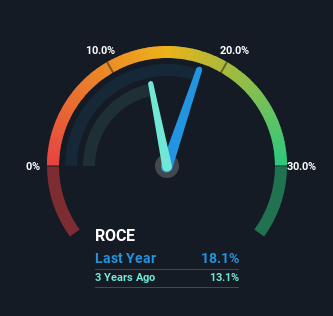Investors Will Want Craftsman Automation's (NSE:CRAFTSMAN) Growth In ROCE To Persist

To find a multi-bagger stock, what are the underlying trends we should look for in a business? Amongst other things, we'll want to see two things; firstly, a growing return on capital employed (ROCE) and secondly, an expansion in the company's amount of capital employed. This shows us that it's a compounding machine, able to continually reinvest its earnings back into the business and generate higher returns. Speaking of which, we noticed some great changes in Craftsman Automation's (NSE:CRAFTSMAN) returns on capital, so let's have a look.
Return On Capital Employed (ROCE): What Is It?
For those that aren't sure what ROCE is, it measures the amount of pre-tax profits a company can generate from the capital employed in its business. To calculate this metric for Craftsman Automation, this is the formula:
Return on Capital Employed = Earnings Before Interest and Tax (EBIT) ÷ (Total Assets - Current Liabilities)
0.18 = ₹4.6b ÷ (₹38b - ₹12b) (Based on the trailing twelve months to March 2023).
Thus, Craftsman Automation has an ROCE of 18%. That's a relatively normal return on capital, and it's around the 15% generated by the Machinery industry.
See our latest analysis for Craftsman Automation

In the above chart we have measured Craftsman Automation's prior ROCE against its prior performance, but the future is arguably more important. If you're interested, you can view the analysts predictions in our free report on analyst forecasts for the company.
How Are Returns Trending?
Investors would be pleased with what's happening at Craftsman Automation. The data shows that returns on capital have increased substantially over the last five years to 18%. Basically the business is earning more per dollar of capital invested and in addition to that, 130% more capital is being employed now too. So we're very much inspired by what we're seeing at Craftsman Automation thanks to its ability to profitably reinvest capital.
On a related note, the company's ratio of current liabilities to total assets has decreased to 33%, which basically reduces it's funding from the likes of short-term creditors or suppliers. Therefore we can rest assured that the growth in ROCE is a result of the business' fundamental improvements, rather than a cooking class featuring this company's books.
What We Can Learn From Craftsman Automation's ROCE
All in all, it's terrific to see that Craftsman Automation is reaping the rewards from prior investments and is growing its capital base. Since the stock has returned a solid 86% to shareholders over the last year, it's fair to say investors are beginning to recognize these changes. With that being said, we still think the promising fundamentals mean the company deserves some further due diligence.
Craftsman Automation does have some risks though, and we've spotted 1 warning sign for Craftsman Automation that you might be interested in.
While Craftsman Automation may not currently earn the highest returns, we've compiled a list of companies that currently earn more than 25% return on equity. Check out this free list here.
New: AI Stock Screener & Alerts
Our new AI Stock Screener scans the market every day to uncover opportunities.
• Dividend Powerhouses (3%+ Yield)
• Undervalued Small Caps with Insider Buying
• High growth Tech and AI Companies
Or build your own from over 50 metrics.
Have feedback on this article? Concerned about the content? Get in touch with us directly. Alternatively, email editorial-team (at) simplywallst.com.
This article by Simply Wall St is general in nature. We provide commentary based on historical data and analyst forecasts only using an unbiased methodology and our articles are not intended to be financial advice. It does not constitute a recommendation to buy or sell any stock, and does not take account of your objectives, or your financial situation. We aim to bring you long-term focused analysis driven by fundamental data. Note that our analysis may not factor in the latest price-sensitive company announcements or qualitative material. Simply Wall St has no position in any stocks mentioned.
About NSEI:CRAFTSMAN
Reasonable growth potential with adequate balance sheet.


